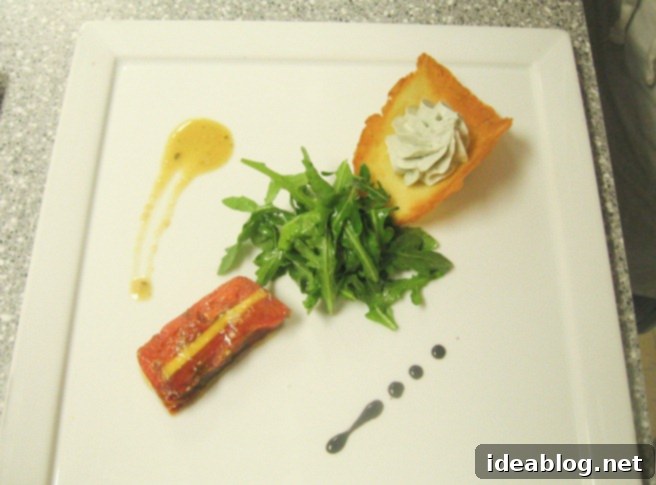Culinary School Thrills: Conquering High-Pressure Production and the Market Basket Challenge
This past week culminated in an exceptionally demanding production day on Thursday, immediately followed by an equally rigorous (our third!) Market Basket challenge on Friday. While both days pushed the limits of our culinary skills and endurance, I’ll first delve into the intensity and intricate details of Thursday’s kitchen experience, which proved to be a significant test of our progress in Phase II of culinary school.
Chef Patrice kicked off our morning lecture with a blunt warning: today would be a true test of our ability to complete an ambitious menu within a tight two-hour window. He emphasized the sheer volume of tasks ahead, a statement that turned out to be a significant understatement by the end of the day. It quickly became evident that this would be the most stressful and demanding day we had encountered yet in Phase II of our culinary program. Our first course, an elegant starter, featured a vibrant tomato terrine. This was meticulously crafted and served alongside a fresh, peppery arugula salad, offering a delightful contrast of flavors and textures. Complementing this, we prepared delicate garlic tuiles, ingeniously fashioned into elegant cones and generously filled with a rich, tangy roquefort cream, a dish that balanced savory crunch with creamy indulgence.
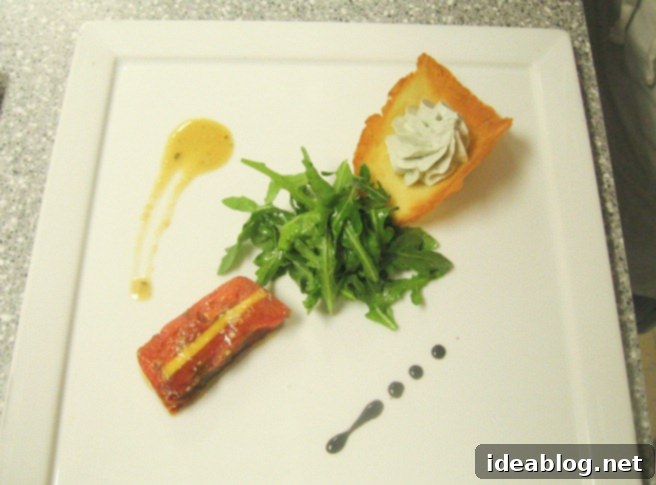
Fortunately, we had been working on the components of the tomato terrine over the preceding two days, which provided a slight buffer against the day’s intense pressure. The lengthy preparation process began with slow-drying ripe plum tomatoes in a very low-heat oven, typically between 180-200 degrees Fahrenheit, for several hours. Before their extended stay in the oven, these tomatoes were lovingly coated with a savory and aromatic mixture of balsamic vinegar, finely minced garlic, and fresh tarragon. This slow-drying technique is absolutely crucial, especially when tomatoes are out of season, as it concentrates their natural sugars and intensifies their flavor dramatically, transforming them into succulent, flavorful gems that taste like the height of summer. It’s a method I’ve mentally bookmarked for a future homemade tomato sauce – imagine the depth of flavor and richness it could impart!
Once the tomatoes achieved their desired texture and profound flavor profile, we carefully peeled off their skins, a delicate and somewhat tedious process that requires patience and a light touch. They were then meticulously packed into a loaf pan, which we had thoughtfully pre-lined with plastic wrap to facilitate easy removal and maintain its perfect form. As a central element in the terrine’s composition, we incorporated a thin, uniform layer of thinly sliced fresh mango, intended to introduce a subtle touch of sweetness and a contrasting tropical note against the savory tomatoes. While the mango did blend surprisingly well with the overall dish, I personally didn’t fall in love with this specific pairing. Reflecting on it, I think I might have preferred a different herb than tarragon, perhaps fresh basil or oregano, to better harmonize with the mango’s sweetness, or even considered omitting the mango entirely for a purer, more focused tomato experience. Every culinary decision is a chance to learn and refine.
During the main production window for the day, which felt like a whirlwind, we also tackled the creation of the exquisite garlic tuile. The recipe for these savory, wafer-thin crisps, we learned, hails directly from the prestigious White House kitchen, a place where Chef Patrice himself honed his formidable skills for many years. The tuile batter was richly infused with a generous amount of microplaned garlic, lending an intense, aromatic flavor to each delicate, golden creation. Concurrently, we prepared the luscious roquefort cream. This involved simply combining the pungent, blue-veined Roquefort cheese with creamy, tangy goat cheese, then whipping the mixture until it was perfectly smooth and pipeable, ready to fill our delicate tuiles. Of all the dishes on the menu, this one felt the most straightforward to assemble, offering a moment of relative calm. However, even seemingly minor tasks, like meticulously picking the tiny stems off the fresh arugula for the accompanying salad, consume valuable time and demand precision in a high-pressure kitchen environment – a constant reminder that perfection truly is in the details, and every second counts.
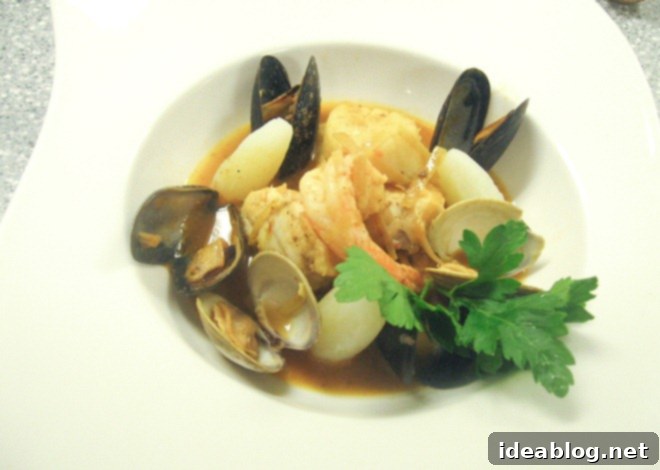
Our main course for this challenging day was the iconic French classic, Bouillabaisse – a rich, complex, and aromatic Provençal seafood stew that is a hallmark of Mediterranean cuisine. Our version was generously laden with an impressive array of fresh seafood, ensuring a luxurious and satisfying experience. This included sweet littleneck clams, plump mussels, succulent shrimp, firm monkfish, and flaky rockfish. The most demanding and time-consuming aspect of preparing this intricate soup was undoubtedly the meticulous cleaning and breaking down of all the diverse seafood components. This involved careful shucking, deveining, skinning, and filleting, ensuring each piece was perfect and ready for cooking. Beyond the seafood, a critical step was fortifying the broth to achieve its characteristic depth and complexity of flavor. We ingeniously leveraged all the fish bones and heads, simmering them for an extended period to extract maximum essence, and further enriched the broth with a high-quality fumet (a concentrated fish stock), adding tons of umami and marine notes. The aromatic foundation for our bouillabaisse was a symphony of spices and fresh ingredients: fragrant fennel seeds, exotic star anise, earthy celery seed, delicate anise seed, an abundance of fresh garlic, and, of course, the indispensable, vibrant strands of saffron, which imparted its signature golden hue and subtle, luxurious flavor.
As if this wasn’t enough to manage within our tight timeframe, we also had the additional task of preparing tourneed potatoes. Chef Brian, a former instructor whose wisdom often echoed through the kitchen, famously used to quip, “Tourneeing is for thinking…” – suggesting a meditative quality to the precise, seven-sided cuts that transform a humble potato into an elegant, uniform shape. On this particular day, however, tourneeing felt less like meditation and more like a frantic exercise in mental arithmetic, desperately calculating how many other complex tasks still awaited completion before service. Each perfectly carved potato was a physical manifestation of the relentless pressure, underscoring the stark contrast to any leisurely culinary practice and highlighting the relentless pace of a professional kitchen environment.
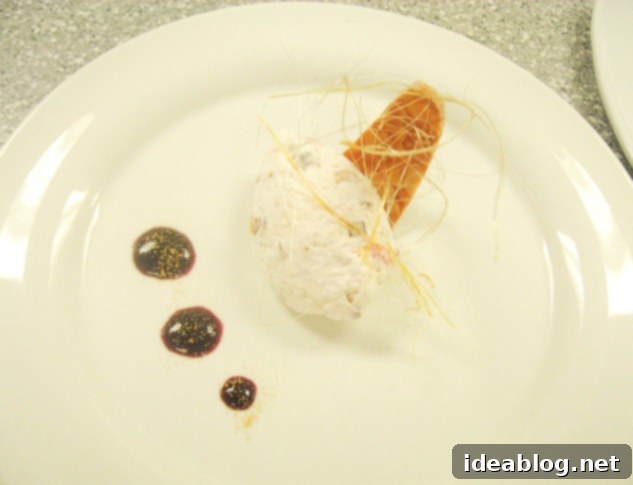
Amidst all these savory preparations and the clamor of the main kitchen, we simultaneously had to orchestrate our dessert: a sophisticated nougat glace, a delightful frozen nougat served elegantly with delicate, complementary nougatine. Nougatine itself is a seemingly simple yet deceptively challenging confection to master, essentially a mixture of rich, amber caramel and thinly sliced, toasted almonds. This molten mixture is then carefully poured onto a Silpat mat, topped with another mat to prevent sticking, and rolled as flat and thin as humanly possible. While the concept sounds straightforward, achieving truly exceptional nougatine requires rolling it to an almost paper-thin consistency, a feat that is far from easy and demands considerable skill and timing.
The inherent challenge lies in caramel’s natural tendency to harden incredibly quickly as it cools. To achieve the desired fragility and thinness, this meant repeatedly returning the nougatine to the oven for brief periods to slightly soften it, allowing for successive rounds of vigorous rolling. This constant back-and-forth process demands immense physical strength and sustained effort – it was a serious workout for the arms, leaving me sweating and, admittedly, more than a little frustrated at times as the clock ticked. While the resulting nougatine tastes undeniably delicious, with its perfect balance of sweetness and crunch, the arduous process of making it is enough to deter me from ever voluntarily attempting it again in my home kitchen. The sheer labor involved truly highlights the dedication, patience, and physical stamina required in professional pastry arts.
To further amplify the difficulty and precision required, we were tasked with cutting the fragile nougatine into long, precise triangles and then skillfully shaping them into tall, elegant crescent forms. Again, this particular step was exceedingly tricky, demanding perfect timing within the fleeting window when the nougatine was pliable enough to work with, yet not so soft that it would lose its delicate shape or so hard that it would crack and shatter. It was a precise dance between temperature control, speed, and delicate manipulation, a true test of pastry chef dexterity and nerve under pressure.
Concurrently, while wrestling with the nougatine, we were also preparing the core of the dessert: the nougat glace itself. This delightful frozen confection is fundamentally an Italian meringue – a stable, glossy base created by slowly pouring hot soft-ball stage sugar syrup into rapidly whisking egg whites. Into this airy meringue, we gently folded finely chopped nougatine (resourcefully utilizing the scraps from our crescent shapes), vibrant candied fruit for bursts of flavor and color, and a generous quantity of freshly whipped cream to lighten the mixture. The entire confection was then carefully chilled until firm, resulting in a rich yet surprisingly airy frozen treat, a perfect contrast to the crunchy nougatine.
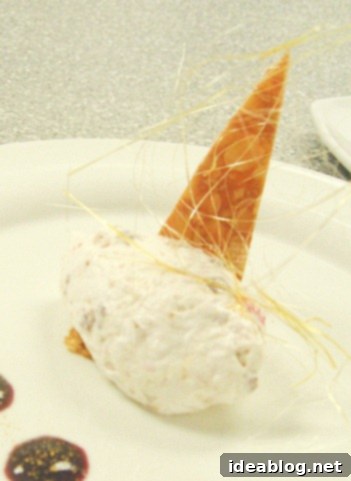
Oh yes, and let’s not overlook the final, delicate, and frankly hazardous touch: intricate spun sugar for décor. This highly specialized technique, involving melting sugar to a caramel stage and then carefully spinning it into fine, hair-like threads, adds an element of ethereal beauty and drama to any dessert presentation. However, working with molten sugar presents significant hazards, making it a constant exercise in caution, precision, and quick reflexes. It was certainly a day that felt like it was actively inviting someone to suffer a nasty burn from scalding sugar. Fortunately, despite the inherent risks and the frantic pace of the kitchen, everyone managed to emerge unscathed, a testament to our focus and the careful instruction we received from our chefs.
The honest truth about the nougat glace? Personally, I found it to be an incredibly time-intensive dessert with a rather “meh” end result. I wasn’t a particular fan of the nougat glace itself, largely because I generally don’t enjoy candied fruit, which was a prominent component in its composition. I also found its texture a bit unusual for my liking, and for my palate, it veered on the side of being overtly sweet. It served as a valuable lesson that not every classical dish or elaborate preparation will resonate with one’s personal taste, even when executed perfectly and according to traditional standards. Sometimes, the journey is more educational than the destination.
Somehow, against all odds and the immense pressure cooker of the kitchen, we all managed to be essentially on time for service – a truly remarkable achievement, considering we accomplished this entire complex three-course menu in just about two hours. However, it was undeniably the most tense and emotionally draining day we’d experienced thus far in our culinary training. By the end of it, the collective stress had us all feeling a bit on edge and probably irritating each other without meaning to. Immediately after service, the accumulated tension finally broke, and I unexpectedly found myself stepping outside the kitchen and breaking down in tears. I believe it was a potent combination of many factors: extreme exhaustion from two relentless weeks with only a single day off, the looming stress of deciding on my externship site, the ongoing challenge of seamlessly integrating with a new partner of only three days, the anticipation of the next day’s daunting Market Basket challenge, and a brief, painful moment of burning my hand on a hot pan handle. Thankfully, after allowing myself that much-needed emotional release, I felt significantly better by the end of the day, ready to face the next challenge with renewed resolve.
A huge thank you to Lyndsay and every single person in my class! Despite our collective feeling of utter exhaustion and feeling quite “crap” by the end of the day, Chef Patrice actually surprised us by commending our excellent performance. He then went on to explain that he intends to give us more days like this, specifically designed to accelerate our speed, refine our efficiency, and ultimately acclimate us to the relentless, high-pressure pace of professional restaurant kitchens. His words were a powerful mix of validation for our hard work and a slightly terrifying glimpse into our future. Yikes – the training clearly doesn’t get easier, but we’re getting tougher!
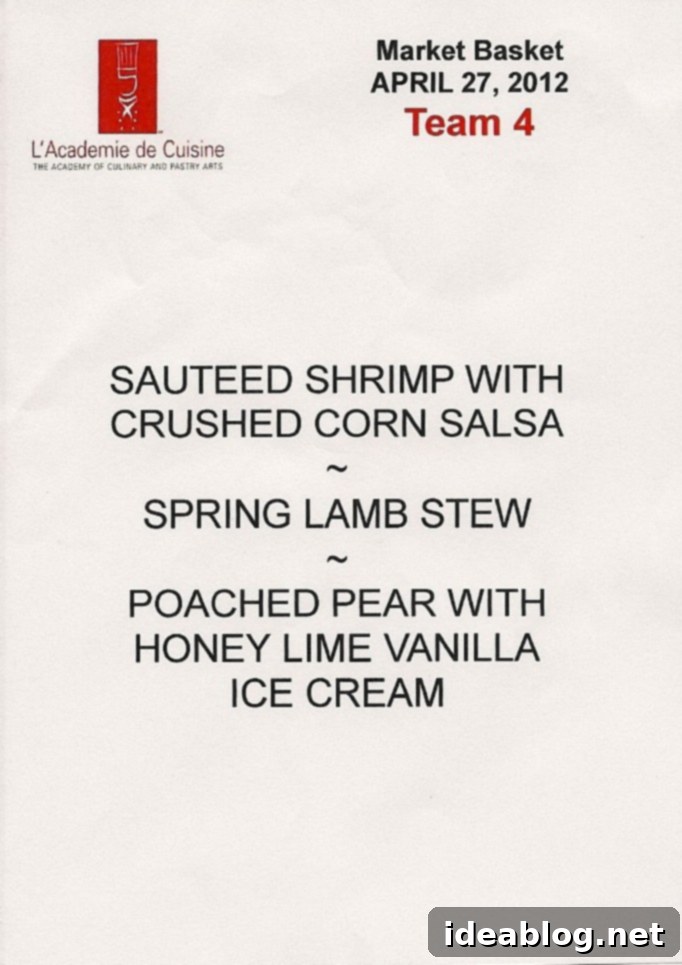
Market Basket Overview: The very next day, Friday, brought our third exhilarating and demanding Market Basket challenge. For this competition, our mystery ingredients were fresh corn, ripe pears, and versatile lamb shoulder – a trio that offered both creative opportunities and inherent challenges. My partner, Blanca, and I collaborated closely to conceptualize and execute a cohesive and delicious three-course meal within the strict time limits. We started with a vibrant appetizer of perfectly sautéed shrimp, elegantly paired with a refreshing fresh corn salsa, which brought a delightful summery freshness. For the main course, we crafted a comforting and flavorful Spring lamb stew, brimming with tender, slow-cooked lamb shoulder and an assortment of fresh, seasonal vegetables that complemented the richness of the meat. Finally, for dessert, we presented a delicate poached pear, beautifully complemented by a unique and delightful honey-vanilla-lime ice cream, offering a sweet, tangy, and refreshing conclusion to our meal. The visiting Chef, who provided feedback for this challenge, was notably tough on everyone, offering pointed critiques that, while intense and sometimes uncomfortable, were incredibly valuable for our growth and understanding of professional culinary standards. On a more positive note, just yesterday, I completed my third “stage” (an unpaid trial shift) at a restaurant in DC! Overall, I believe I had my best experience yet at this particular establishment and will most likely choose it as my externship site, marking a significant and exciting step in my culinary career journey. I do plan to potentially visit one or two more restaurants, just to be absolutely sure and explore all my options, before making my final, pivotal decision!
As for the remainder of the weekend, I am immensely excited to have two glorious full days off before diving back into school for what promises to be another tough, yet undoubtedly eventful, week of culinary exploration and rigorous training. These days off are a much-needed respite to recharge and prepare for the challenges ahead. Keep an eye out for a new recipe post that I’ll be sharing over the next day or two – something delicious to tide you over until the next update on my ongoing culinary adventures!
